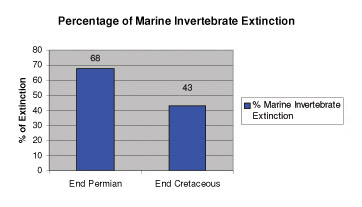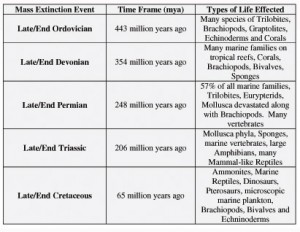Mass Extinctions – Putting the “Big Five” into Perspective
Extinction Events are happening all the Time
The mass extinction event that marked the end of the Cretaceous (end of the Mesozoic Era), is perhaps the best known of all the mass extinction events (primarily as this event saw the demise of the dinosaurs); it was not the most severe in terms of the loss of families of organisms, genera and individual species.
The extinction event that marked the end of the Permian (also the end of the Palaeozoic Era), had a far bigger impact on animal life than the extinction event that marked the end of the Cretaceous.
Percentage Marine Invertebrate Extinction (Genera level of Taxon)

Source: Everything Dinosaur
From the graph shown above it can be seen that the extinction event at the end of the Permian resulted in the loss of approximately 68% of all the marine invertebrate genera, whilst the Cretaceous extinction event marked the loss of 43% of marine invertebrate genera.
Mass Extinctions
From time to time major groups of fossils disappear from the geological record. Many groups of fossils disappear more or less together (roughly at the same point in geological time), the fossils never to be found again in younger strata. It was partly for this reason that many of the boundaries between geological periods and eras were created by scientists, as they are appropriate points to delineate time.
Species are becoming extinct all the time (this is referred to as background extinction), new species are evolving (speciation), to take advantage of new environmental and climatic circumstances. There have been a number of major extinctions throughout geological time. Although, evidence is extremely scarce for extinction events during the Cryptozoic (hidden life Eon – 4.6 bn years to 545 million years ago), it is almost certain that as Precambrian life forms evolved some elements were subjected to extinction events.
The major mass extinctions, known as the “Big Five” have all taken place in the Phanerozoic (visible life Eon). None of them seemed to have been instantaneous, in most cases it seems to have taken between 500,000 and one million years for the losses to occur. However, recent evidence regarding the Permian extinction event is that it may have taken place quite rapidly (at least in geological time terms), perhaps taking place over a period of around 100,000 years.
To read more about the mass extinction at the end of the Permian: Can Snails and Oysters provide a clue to Mass Extinctions.
Naturally, the collision with a large extra-terrestrial object such as a comet or an asteroid around 65 million years ago would have had a catastrophic impact on life on Earth but there is evidence to suggest that many land and marine animals were already suffering considerable stress before the Chicxulub event.
To review recent articles published on the Cretaceous mass extinction:
Sulphur linked to Cretaceous extinction event: Sulphur in the Sky linked to Dinosaur Extinction.
To read more about the Chicxulub impact: Geologists get to the Bottom of the Chicxulub Crater.
More information about Chicxulub: End of Dinosaurs set in Motion by Asteroid Collision in Mid Jurassic.
The major extinction events, known as the “Big Five” led to the demise of a number of key animal groups, some went completely extinct such as the dinosaurs at the end of the Cretaceous, some such as the Brachiopods were subjected to a number of mass extinction events. Although Brachiopods still exist today, they do not have the diversity or abundance as during their Palaeozoic heyday.
A Table Summarising the Main Groups of Animals Affected by Mass Extinctions
Table: Everything Dinosaur
A lot of information is available about current climate and environmental change. It is difficult to interpret this data sufficiently to estimate the current extinction rate. Many biologists believe that over the last 200 years or so the extinction rate has been much higher than the normal background rate of extinction. Conservative estimates of current total extinction rates are 5-50 species of animals and plants per day. This is an alarming figure, taking the mid range point (25) this would suggest that 600 species have gone extinct so far in March 2008.
Such is the loss of fauna and flora that many scientists have labelled this time as “The Sixth Extinction”. The fossil record indicates that it takes millions of years for the Earth to regenerate biodiversity and establish rich, robust ecosystems. Mass extinction events seem to have serious implications for larger animals, particularly those at the top of the food-chain, perhaps it is time for H. sapiens to take note.
Visit Everything Dinosaur’s website: Everything Dinosaur.


